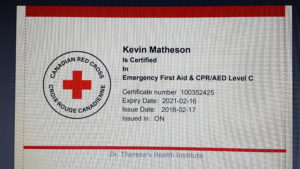Luckily in my 31 years of practicing as a Chiropractor, I have never seen someone have a heart attack. However, the odds are good that I will, or anyone will for that matter. Do you feel confident you would know what to do if someone was clutching their chest, complaining of heartburn, sweating, complaining of pain in the back or arm, experiencing pressure in the chest, or feeling extremely fatigued?
Last week-end I took part in an intensive refresher course in CPR and First Aid. CPR is short for Cardiopulmonary Resuscitation, a skill that is only used if the heart has stopped beating, or is beating so inefficiently that it doesn’t deliver enough oxygen to the brain. This is called cardiac arrest when the heart stops or defibrillation when it beats inefficiently. Either way a combination of chest compressions and artificial breathing can continue to circulate oxygen to the brain and some other parts of the body. Without this, brain damage will occur in 4 to 6 minutes.
I joined 17 Chiropractors to refresh my understanding of what happens with cardiac arrest, what conditions can contribute to it and what can be done as soon as possible. For many of us, this is simply a refresher but it never ceases to impress me how important this material is. Any of us could be called upon to assess the situation, take charge (we may be the only person there), check if the victim is breathing and start performing CPR. Thinking has changed from years ago when we used to check the pulse. Now we know how important those chest compressions are and how they need to be started asap, if they are not breathing and you have the proper training. Hopefully your victim will respond in the first few minutes and you can stop. However if they don’t, you may need to continue until the EMS – Emergency Medical Services arrives on scene. Most commonly the Firefighters arrive first, then the ambulance with Paramedics or the police. We also learned how to use an AED – Automated External Defibrillator since almost half of heart attacks require the shock from a ‘Defib’ machine in order to get the heart rhythm back on track.
As for First Aid, we learned about the most common accidents or sudden illnesses that can arise that need some quick attention before the EMS arrives. From cuts and fractures to burns and concussions, it’s good to review these conditions regularly.
If you can find some time, I highly recommend enrolling in a course through the Canadian Red Cross or the Heart and Stroke Foundation. Your family and friends will thank you.



